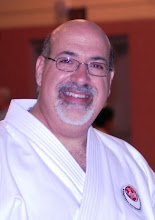 Speed, Speed, Speed…
Speed, Speed, Speed…Power that is instantaneous and formidable!
In a decisive technique, there is a power that is instantaneous and formidable. The basic techniques of Karate are influenced to a very great extent by speed. It may be a bit of an exaggeration to that in training in techniques, speed is first in importance and second in importance, but it is no exaggeration to say that the objective if basic training is maximizing speed.
Since the body is organized in thee basic parts, power comes from increasing speed in all of them. If the muscles involved are contracted as fast as possible, then the power that reaches the hand in punching, in order to take advantage of the pairing of forces that comes from withdrawing the other arm, it must be with drawn as fast as possible.
Speed is dependant, for one thing, on muscle control. When certain muscles contract, other muscles expand. In punching, for example, the triceps expand while the biceps strong contract. If proper coordination between the expansion and contraction is lacking, then the movement of the arm will not be smooth and an effective punching technique is not possible.
Beginners have a tendency to use unnecessary muscles. As a student, you must accept guidance and, according to your training, learn to control your muscles.






